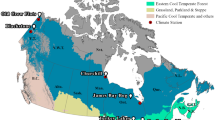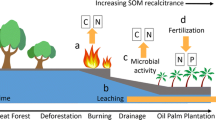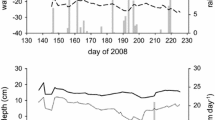Abstract
Although studies have shown that peatland drainage andharvesting alter local hydrology, microclimate, and peatcharacteristics, little is known about the effects of these changes onCO2 production rates. This study examines the differentfactors affecting CO2 production from natural and cutoverpeatlands. Laboratory peat incubations were performed under aerobic andanaerobic conditions to determine the influence of temperature, soilmoisture, and peat depth on CO2 production rates from peatsamples taken from: (1) a natural peatland; (2) a 2-yearpost-cutover peatland and; (3) a 7-year post-cutover peatland.
CO2 production rates ranged from 0.21 to 4.87 µmolg−1 d−1 under anaerobic conditions,and from 0.37 to 15.69 µmol g−1d−1 in the aerobic trials. While no significantdifferences were found between the CO2 production rates ofthe two cutover sites, the natural site consistently displayed higherproduction values. The natural site was also the only site to exhibitstrong depth dependent trends, thus indicating the importance of theupper peat layer with respect to substrate quality. Higher productionrates were found under aerobic than anaerobic conditions, with thegreatest response to oxygen observed at the natural site. Productionrates increased with both temperature and soil moisture, with maximumproduction rates found at 20 °C and 92% moisture content.Temperature responses were generally greater at the cutover sites, whilesoil moisture had greater effects on the natural site peat.
Results of this work agree with previous studies that suggest that itis essential to begin restoration once a cutover peatland is abandoned.Re-wetting a cutover peatland (through restoration practices) isnecessary to prevent an increase in peat temperature and CO2production since cutover peat has higher Q10 values thannatural peat. A decrease in overall peatland oxidation should reduce thepersistent source of atmospheric CO2 from cutover peatlandsand the irreversible changes in peat structure that impedeSphagnum re-establishment.
Similar content being viewed by others
References
Bridgham SD &Richardson CJ (1992) Mechanisms controlling soil respiration (CO2 and CH4) in southern peatlands. Soil Biol. Biochem. 24(11): 1089-1099
Bubier JL &Moore TR (1994) An ecological perspective on methane emissions from northern wetlands. Tree 9(12): 460-464
Campeau S &Rochefort L (1996) Sphagnum regeneration on bare peat surfaces: field and greenhouse experiments. J. Appl. Ecol. 33: 599-608
Christensen TR,Jonasson S,Callaghan TV &Havström M (1999) On the potential CO2 release from tundra soils in a changing climate. Appl. Soil Ecol. 11: 127-134
Ferland C &Rochefort L (1997) Restoration techniques for Sphagnum dominated peatlands. Can. J. Bot. 75: 1110-1118
Gorham E (1995) The biogeochemistry of northern peatlands and its possible response to global warming. In: Woodwell GM &Mackenzie FT (Eds) Biotic Feedback in the Global Climate System: Will the warming feed the warming? (pp 169-187). Oxford University Press, New York
Grosvernier PH,Matthey Y &Buttler A (1995) Microclimate and physical properties of peat: New clues to the understanding of bog restoration processes. In: Wheeler BD,Shaw SC,Fojt WJ &Robertson RA (Eds) Restoration of Temperate Wetlands (pp 435-450). John Wiley & Sons, Chichester, UK
Hogg EH,Lieffers VJ &Wein RW (1992) Potential carbon losses from peat profiles: effects of temperature, drought cycles and fire. Ecol. Appl. 2(3): 298-306
Johnson LC,Damman AWH &Malmer N (1990) Sphagnum macrostructure as an indicator of decay and compaction in peat cores from an ombrotrophic south Swedish peat-bog. J. Ecol. 78: 633-647
Lekkerkerk L,Lundkvist H,Agren G,Ekbohm G &Bosatta E (1990) Decomposition of heterogeneous substrates: An experimental investigation of a hypothesis on substrate and microbial properties. Soil Biol. Biochem. 22(2): 161-167
Magnusson T (1993) Carbon dioxide and methane formation in forest mineral and peat soils during aerobic and anaerobic incubations. Soil Biol. Biochem. 25: 877-883
McKenzie C,Schiff S,Aravena R,Kelly C &St. Louis V (1998) Effect of temperature on production of CH4 and CO2 production from peat in a natural and flooded boreal forest eetland. Climate Change 40: 247-266
Moore TR &Dalva M (1993) The influence of temperature and water table position on carbon dioxide and methane emissions from laboratory columns of peatland soils. J. Soil Sci. 44: 651-664
Nadelhoffer KJ,Giblin AE,Shaver GR &Laundre JA. (1991) Effects of temperature and substrate quality on element mineralization in six arctic soils. Ecology. 72(1): 242-253
Nilsson M &Bohlin E (1993) Methane and carbon dioxide concentrations in bogs and fens-with special reference to the effects of the botanical composition of the peat. J. Ecol. 81: 615-625
North American Wetlands Conservation Council (Canada) (1998) Peat Moss and the Environment: Canadian Peatland Facts. http://www.peatmoss.com/pm-me3.html. Accessed 27 March, 1998
Orchard VA,Cook FJ &Corderoy DM (1992) Field and laboratory studies on the relationships between respiration and moisture for two soils of contrasting fertility status. Pedobiologia 36: 21-33
Okruszko, H (1995) Influence of hydrological differentiation of fens on their transformation after dehydration and on possibilities for restoration. In Wheeler BD et al. (Eds) Restoration of Temperate Wetlands (pp 300-305). John Wiley & Sons Ltd., New York
Prévost M,Belleau P &Plamondon AP (1997) Substrate conditions in a treed peatland: Responses to drainage. Ecoscience 4(4): 543-554
Price JS (1996) Hydrology and microclimate of a partly restored cutover bog, Quebec. Hydrol. Proc. 10: 1263-1272
Price JS (1997) Soil moisture, water tension, and water table relationships in a managed cutover bog. J. Hydrol. 202: 21-32
Rotenberg PA (1999) Effect of temperature and substrate quality on CO2 production in a natural and harvested peatland. B.A.Sc. Thesis, McMaster University, Hamilton, Ontario p. 48
Silvolva J &Ahlholm U (1989) Effects of moisture and temperature on the decomposition of milled and sod peat. Proc. Int. Symposium on Peat/Peatland Characteristics and Uses. May 16-20, 1989
Silvolva J,Alm J,Ahlholm U,Nykänen H &Martikainen PJ (1996) CO2 fluxes from peat in boreal mires under varying temperature and moisture conditions. J. Ecol. 84: 219-228
Updegraff K,Pastor J,Bridgham SD &Johnston CA (1995) Environmental and substrate controls over carbon and nitrogen mineralization in northern wetlands. Ecol. Appl. 5(1): 151-163
Waddington JM &Roulet NT (2000) Carbon balance of a patterned boreal peatland. Global Change Biol. 6: 1-15
Waddington JM,Warner KD &Kennedy GW (2001) Cutover peatlands: A persistent source of atmospheric CO2. Global Biogeochem. Cycles. Submitted January, 2001
Zak DR, Holmes WE,MacDonald NW & KS Pregitzer (1999) Soil temperature, matric potential, and the kinetics of microbial respiration and nitrogen mineralization. Soil Sci. Soc. Am. J. 63: 575-584
Author information
Authors and Affiliations
Corresponding author
Rights and permissions
About this article
Cite this article
Waddington, J., Rotenberg, P. & Warren, F. Peat CO2 production in a natural and cutover peatland: Implications for restoration. Biogeochemistry 54, 115–130 (2001). https://doi.org/10.1023/A:1010617207537
Issue Date:
DOI: https://doi.org/10.1023/A:1010617207537




